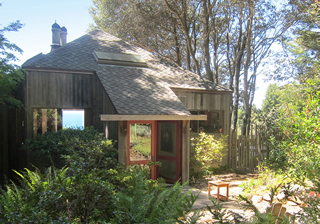Soul-searching by the Sea - Page 3
 |
|
|
 |
|
|
 |
|
|
It's not surprising that this architecture originated largely in Berkeley, where the 'First Bay Tradition' of architecture, exemplified by Bernard Maybeck, gloried in untreated wood and evoked rustic country cabins and barns, and where the 'Second Bay Tradition' married this Arts & Crafts thinking with open planned, glass-walled modernism.
The earliest Sea Ranch architects, who developed the vocabulary that would be locked into place through design rules that remain in effect to this day, included Joseph Esherick, the firm of MLTW (Charles Moore, Donlyn Lyndon, William Turnbull, Richard Whitaker), George Homsey, and a handful of others.
They were deeply influenced by vernacular rural architecture in Sonoma and Mendocino, and the nearby "great wooden stockade of Fort Ross" was "even more on our minds," Lyndon wrote in his book The Sea Ranch.
Author David Littlejohn described the Sea Ranch look in a 1991 article: "weathered wood shingles or vertical siding, un-mullioned and un-shuttered windows asymmetrically set, eave-less shed roofs, double-height living rooms, metal pipe chimneys, a sliced cubistic volume."
Sea Ranch style, more than any other Bay tradition, took on a life of its own, with beach houses on Fire Island, ski cabins, and condo complexes everywhere adopting at least its outward appearance.
Despite the developer's emphasis on nature, the decision to create Sea Ranch essentially as a gated community without gates outraged conservationists. Outsiders, in the main, would be banned from its streets, from hiking its forested hillside trails—or from visiting the beach.
And in California, beaches are by law public land.
In part because of Sea Ranch, the state voted in 1972 for an initiative that created the California Coastal Commission to regulate coastal development and ensure public access.
The Coastal Commission demanded that Sea Ranch open its beaches to the public and refused to permit new homes. The commission's moratorium on Sea Ranch lasted until 1980.
"The Sea Ranch," the Sierra Club's coastal coordinator, Norbert Dall, said in 1977, "has become the symbol of the problems created by huge land developments in rural sections of the coast."
The fight over coast access divided the young community, and Whitaker was in the minority that favored access.
"'There will be hordes of people tramping across the Sea Ranch.' Those very words were said by a very close friend of mine, and we had an argument that almost ended our friendship," Whitaker said. "I said, until they build a four-lane divided highway up here and take all the curves out of the road, there will not be hordes of people swarming over the Sea Ranch."




